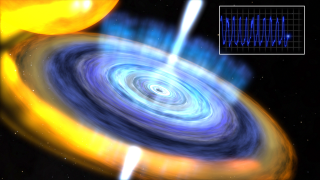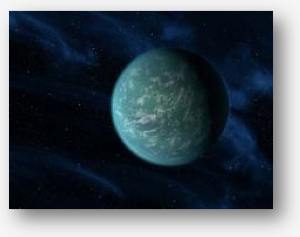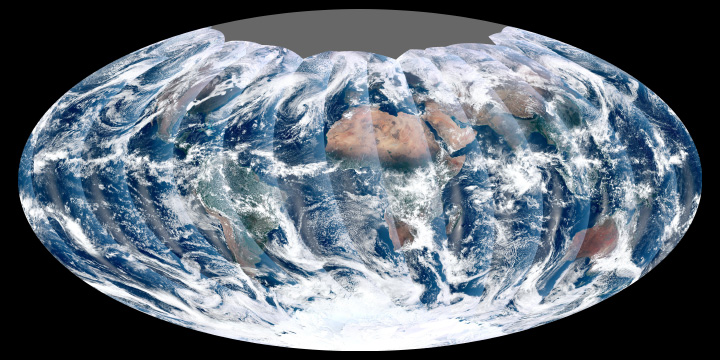 Dr. Richard Boitnott, lead test engineer at the Landing and Impact Research Facility at NASA’s Langley Research Center, has the kind of job almost any student would love — he gets to crash things and see what happens. In this program, Boitnott show you some of the crucial tests he conducts and explains how he uses technology to collect data.
Dr. Richard Boitnott, lead test engineer at the Landing and Impact Research Facility at NASA’s Langley Research Center, has the kind of job almost any student would love — he gets to crash things and see what happens. In this program, Boitnott show you some of the crucial tests he conducts and explains how he uses technology to collect data.
Month: January 2012
NASA Detects 'Heartbeat' of Smallest Black Hole Candidate
 An international team of astronomers has identified a candidate for the smallest-known black hole by using data from NASA’s Rossi X-ray Timing Explorer. The evidence comes from a specific type of X-ray pattern, nicknamed a “heartbeat” because of its resemblance to an electrocardiogram. The pattern until now has been recorded in only one other black hole system.
An international team of astronomers has identified a candidate for the smallest-known black hole by using data from NASA’s Rossi X-ray Timing Explorer. The evidence comes from a specific type of X-ray pattern, nicknamed a “heartbeat” because of its resemblance to an electrocardiogram. The pattern until now has been recorded in only one other black hole system.
Link to the NES Virtual Campus home page.
NASA's Kepler Mission Discovery Relates to NES Lesson
 NASA’s Kepler mission has confirmed its first planet in the “habitable zone,” the region where liquid water could exist on a planet’s surface. Kepler has discovered more than 1,000 new planet candidates, nearly doubling its previously known count. Ten of these candidates are near-Earth-size and orbit in the habitable zone of their host star. Candidates require follow-up observations to verify they are planets.
NASA’s Kepler mission has confirmed its first planet in the “habitable zone,” the region where liquid water could exist on a planet’s surface. Kepler has discovered more than 1,000 new planet candidates, nearly doubling its previously known count. Ten of these candidates are near-Earth-size and orbit in the habitable zone of their host star. Candidates require follow-up observations to verify they are planets.
Link to the NES Virtual Campus home page.
Support Your NES Meteorology Lessons with NPP Imagery
 The Visible Infrared Imager Radiometer Suite on board NPOESS Preparatory Project, or NPP, NASA’s newest Earth-observing satellite, acquired its first measurements on Nov. 21, 2011. The resulting high-resolution image shows a broad swath of eastern North America, from Canada’s Hudson Bay past Florida, to the northern coast of Venezuela in South America.
The Visible Infrared Imager Radiometer Suite on board NPOESS Preparatory Project, or NPP, NASA’s newest Earth-observing satellite, acquired its first measurements on Nov. 21, 2011. The resulting high-resolution image shows a broad swath of eastern North America, from Canada’s Hudson Bay past Florida, to the northern coast of Venezuela in South America.
Link to the NES Virtual Campus home page.
NASA Now: The Sun: The Impact of Solar Activity on Earth
 Meet Mitzi Adams, an astrophysicist studying the sun. Adams has been working as a solar scientist at NASA’s Marshall Space Flight Center in Huntsville, Ala., since 1988. She analyzes data in an attempt to predict solar flares and coronal mass ejections, or CMEs. Knowing when a solar flare, or CME, is going to occur is important for our satellites in orbit, for astronauts in space, and even for power companies on the ground. Instruments on board satellites now improve these predictions. In this episode, Adams presents the latest information about the sun’s layers, coronal mass ejections, solar flares and solar cycles.
Meet Mitzi Adams, an astrophysicist studying the sun. Adams has been working as a solar scientist at NASA’s Marshall Space Flight Center in Huntsville, Ala., since 1988. She analyzes data in an attempt to predict solar flares and coronal mass ejections, or CMEs. Knowing when a solar flare, or CME, is going to occur is important for our satellites in orbit, for astronauts in space, and even for power companies on the ground. Instruments on board satellites now improve these predictions. In this episode, Adams presents the latest information about the sun’s layers, coronal mass ejections, solar flares and solar cycles.
This program is available on the NES Virtual Campus website beginning Jan 4, 2012.
NASA Now: Origins and Evolution of the Universe: Cosmic Dust
 This episode of NASA Now highlights recently discovered wonders of the universe as well as common cosmic dust. Discover how these microscopic particles floating in space could hold the key to the origins of the universe. And learn about an activity that introduces all the known chemical elements.
This episode of NASA Now highlights recently discovered wonders of the universe as well as common cosmic dust. Discover how these microscopic particles floating in space could hold the key to the origins of the universe. And learn about an activity that introduces all the known chemical elements.
